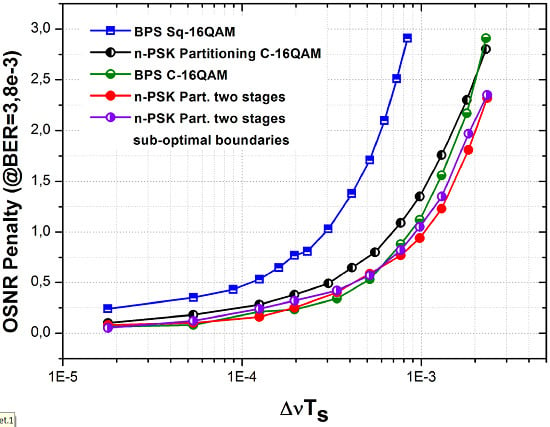Two-Stage n-PSK Partitioning Carrier Phase Recovery Scheme for Circular mQAM Coherent Optical Systems
Abstract
:1. Introduction
2. Two-Stage n-PSK Partitioning Scheme for C-mQAM
3. Simulation Setup and Results
4. Experimental Setup and Results
5. Computational Complexity
- Each of the decision symbol circuit modules requires DCmult, DCsum, and DCcomp multiplications, summations, and comparisons, respectively.
- The summation of the I and Q components of M2 symbols requires 2M2 − 2 adders.
- The division inside the argument function requires one multiplication. A small look-up table can be used for the argument calculation. Unwrap operation requires a comparator and one summation. Multiplications and divisions of the power of two can be performed through bitwise shifting operations.
- In order to retrieve the I and Q components a small size look up table is required. Two comparators and an adder are needed to keep the calculated value in the range of [0,2π).
- 4M2 multiplications and 2M2 summations are required for phase correction of the input symbols.
6. Conclusions
Acknowledgments
Author Contributions
Conflicts of Interest
Abbreviations
| CPR | carrier phase recovery |
| ΔνTs | combined linewidth symbol duration product |
| n-PSK | n-level phase shift keying |
| BPS | blind phase search |
| DSP | digital signal processing |
| Sq-QAM | square quadrature amplitude modulation |
| OSNR | optical signal-to-noise ratio |
| V&V | Viterbi and Viterbi |
| AWGN | additive white Gaussian noise |
| PRBS | pseudorandom bit sequence |
| BER | bit error rate |
| BPSSq-mQAM | blind phase search in square multilevel quadrature amplitude modulations |
| BPSC-mQAM | blind phase search in circular multilevel quadrature amplitude modulations |
| FEC | forward error correction |
| PM | phase modulator |
| EDFA | erbium doped fiber amplifier |
| OBPF | optical band pass filter |
| LO | local oscillator |
| DSO | digital signal oscilloscope |
| AWG | arbitrary waveform generator |
| DC | decision circuit |
| DCmult | decision circuit complexity in terms of multipliers |
| DCsum | decision circuit complexity in terms of summations |
| DCcomp | decision circuit complexity in terms of comparators |
References
- Savory, S.J. Digital Coherent Optical Receivers: Algorithms and Subsystems. IEEE J. Sel. Top. Quantum Electron. 2010, 16, 1164–1179. [Google Scholar] [CrossRef]
- Pfau, T.; Hoffman, S.; Noé, R. Hardware-Efficient coherent digital receiver concept with feed forward carrier recovery for m-QAM constellations. J. Lightw. Technol. 2009, 27, 989–999. [Google Scholar] [CrossRef]
- Viterbi, A.; Viterbi, A. Nonlinear phase estimation of PSK-modulated carrier phase with application to burst digital transmission. IEEE Trans. Inf. Theory 1983, 29, 543–531. [Google Scholar] [CrossRef]
- Seimetz, M. Laser Linewidth Limitations for Optical Systems with High-Order Modulation Employing Feed Forward Digital Carrier Phase Estimation. In Proceedings of the Optical Fiber Communication Conference and Exhibition (OFC), San Diego, CA, USA, 24–28 February 2008.
- Louchet, H.; Kuzmin, K.; Richter, André. Improved DSP algorithms for coherent 16-QAM transmission. In Proceedings of the European Conference and Exhibition on Optical Communications (ECOC), Brussels, Belgium, 21–25 September 2008.
- Fatadin, I.; Ives, D.; Savory, S.J. Laser Linewidth Tolerance for 16QAM Coherent Optical Systems Using QPSK Partitioning. Photonics Technol. Lett. 2010, 22, 631–633. [Google Scholar] [CrossRef]
- Su, X.; Xi, L.; Tang, X.; Zhang, Z.; Bai, S.; Zhang, W.; Zhang, X. A Multistage CPE Scheme Based on Crossed Constellation Transformation for M-QAM. Photonics Technol. Lett. 2015, 27, 77–80. [Google Scholar]
- Zhong, K.P.; Ke, J.H.; Gao, Y.; Cartledge, J.C. Linewidth-Tolerant and Low-Complexity Two-stage Carrier Phase Estimation Based on Modified QPSK Partitioning for Dual-Polarization 16-QAM Systems. J. Lightw. Technol. 2013, 31, 50–57. [Google Scholar] [CrossRef]
- Zhang, F.; Wu, J.; Li, Y.; Xu, K.; Lin, J. Multi-Stage feed-forward optical carrier phase estimation based on QPSK partitioning for 64-QAM signals. Opt. Int. J. Light Electron. Opt. 2013, 124, 2557–2560. [Google Scholar] [CrossRef]
- Ke, J.H.; Zhong, K.P.; Gao, Y.; Cartledge, J.C.; Karar, A.S.; Rezania, M.A. Linewidth-Tolerant and Low-Complexity Two-Stage Carrier Phase Estimation for Dual-Polarization 16-QAM Coherent Optical Fiber Communications. J. Lightw. Technol. 2012, 30, 3987–3992. [Google Scholar] [CrossRef]
- Xiang, M.; Fu, S.; Deng, L.; Tang, M.; Shum, P.; Liu, D. Low-Complexity feed-forward carrier phase estimation for M-ary QAM based on phase search acceleration by quadratic approximation. Opt. Express 2015, 23, 19142–19153. [Google Scholar] [CrossRef] [PubMed]
- Bilal, S.M.; Bosco, G.; Cheng, J.; Lau, A.P.T.; Lu, C. Carrier Phase Estimation through the Rotation Algorithm for 64-QAM Optical Systems. J. Lightw. Technol. 2015, 33, 1766–1773. [Google Scholar] [CrossRef]
- Navarro, J.R.; Olmedo, M.I.; Kakkar, A.; Pang, X.; Ozolins, O.; Schatz, R.; Jacobsen, R.; Popov, S.; Zibar, D. Phase noise tolerant carrier recovery scheme for 28Gbaud circular 16QAM. In Proceedings of the European Conference and Exhibition on Optical Communications (ECOC), Valencia, Spain, 27 September–1 October 2015.
- Navarro, J.R.; Kakkar, A.; Pang, X.; Ozolins, O.; Schatz, R.; Olmedo, M.I.; Jacobsen, G.; Popov, S. Carrier Phase Recovery Algorithms for Coherent Optical Circular mQAM Systems. J. Lightw. Technol. 2016, 34, 2717–2723. [Google Scholar] [CrossRef]
- Zafra, S.O.; Pang, X.; Jacobsen, G.; Popov, S.; Sergeyev, S. Phase noise tolerance study in coherent optical circular QAM transmissions with Viterbi-Viterbi carrier phase estimation. Opt. Express. 2014, 22, 30579–30585. [Google Scholar] [CrossRef] [PubMed]
- VPIphotonics. Available online: http://www.vpiphotonics.com.
- Kikuchi, K. Characterization of semiconductor-laser phase noise and estimation of bit-error rate performance with low-speed offline digital coherent receivers. Opt. Express 2012, 20, 5291–5302. [Google Scholar] [CrossRef] [PubMed]
- Zuraidah, Z.; Lowery, A.J. Experimental demonstration of a flexible and stable semiconductor laser linewidth emulator. Opt. Express 2010, 18, 13880–13885. [Google Scholar]
- Gardner, F. A BPSK/QPSK Timing-Error Detector for Sampled Receivers. Trans. Commun. 1986, 34, 423–429. [Google Scholar] [CrossRef]
- Winzer, P.J.; Gnauck, A.H.; Doerr, C.R.; Magarini, M.; Buhl, L.L. Spectrally Efficient Long-Haul Optical Networking Using 112-Gb/s Polarization-Multiplexed 16-QAM. J. Lightw. Technol. 2010, 28, 4, 547–556. [Google Scholar] [CrossRef]
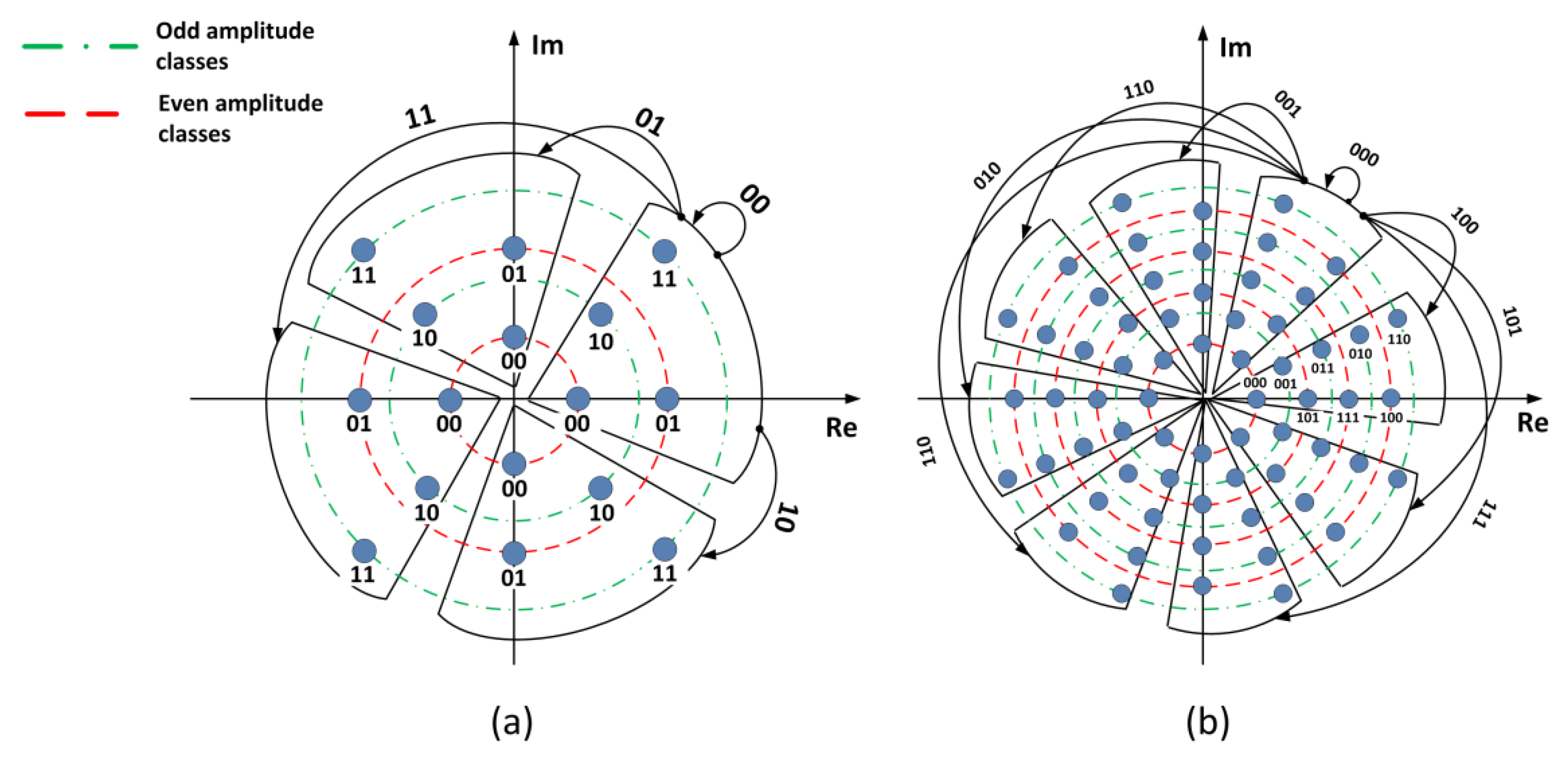

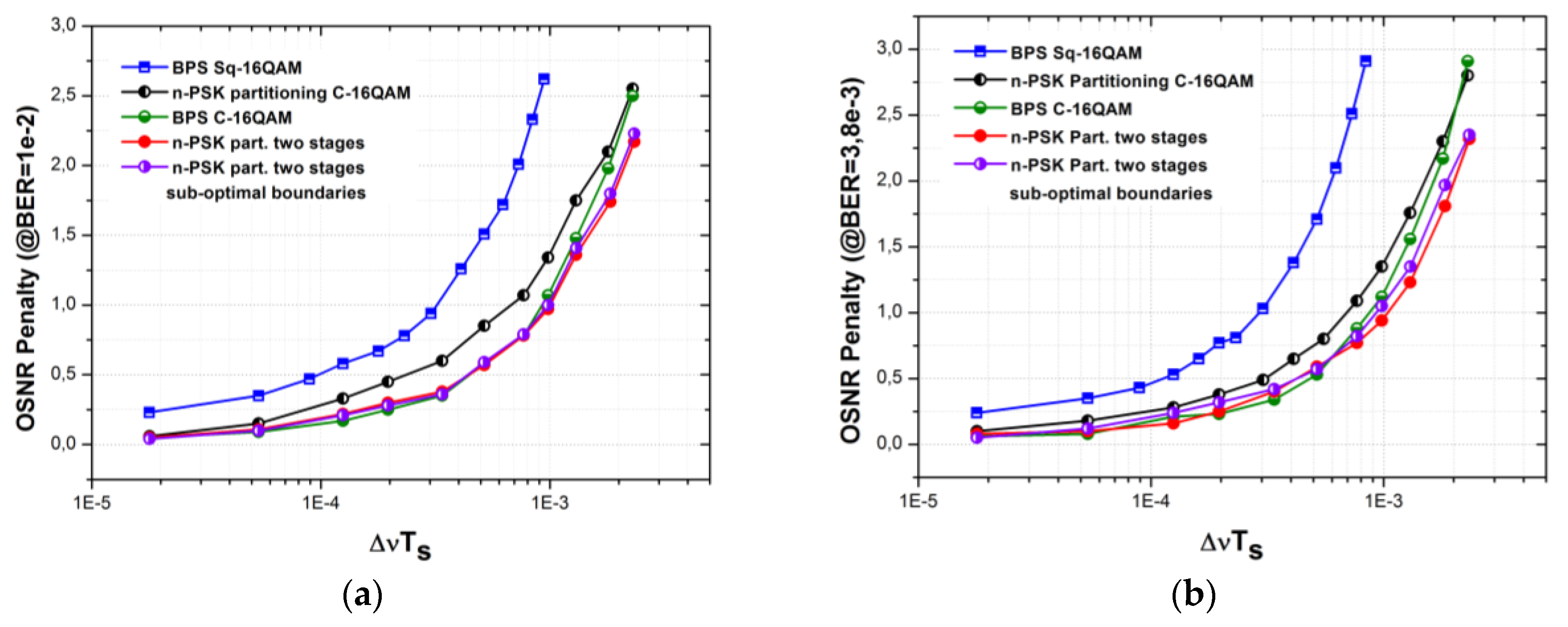
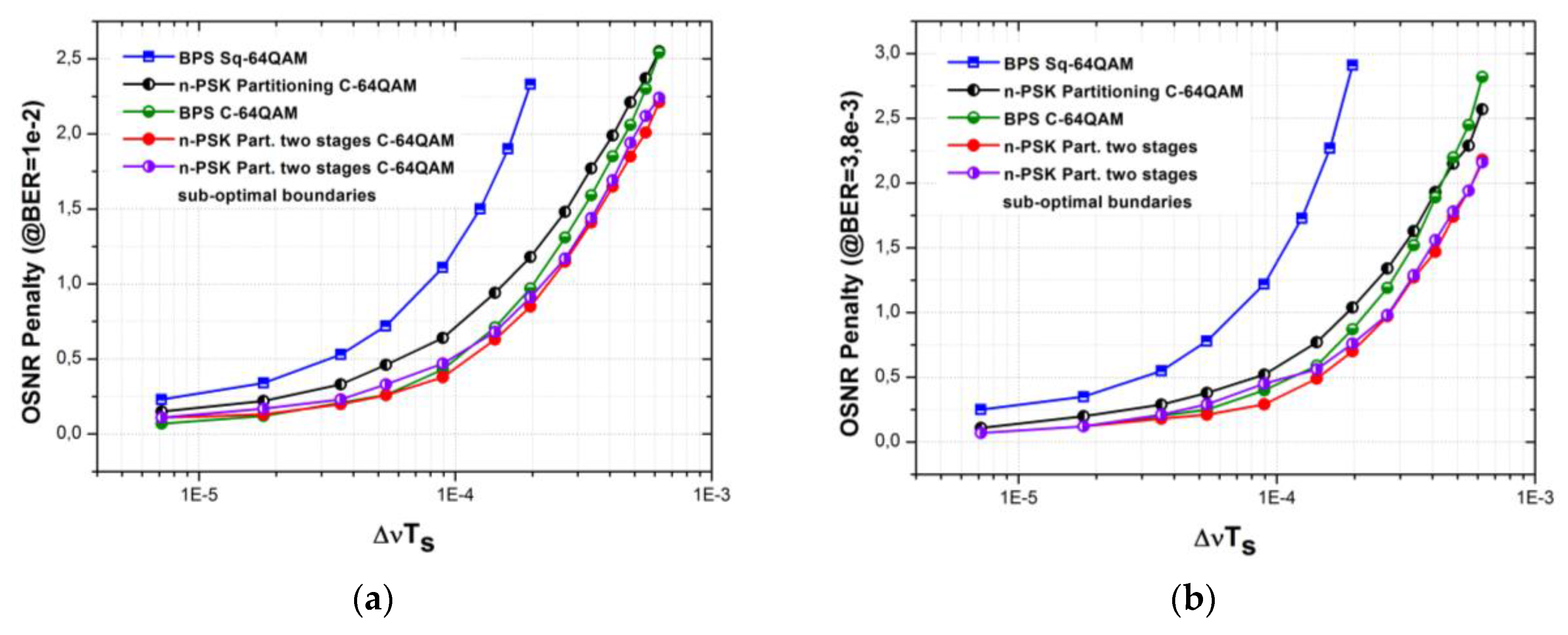
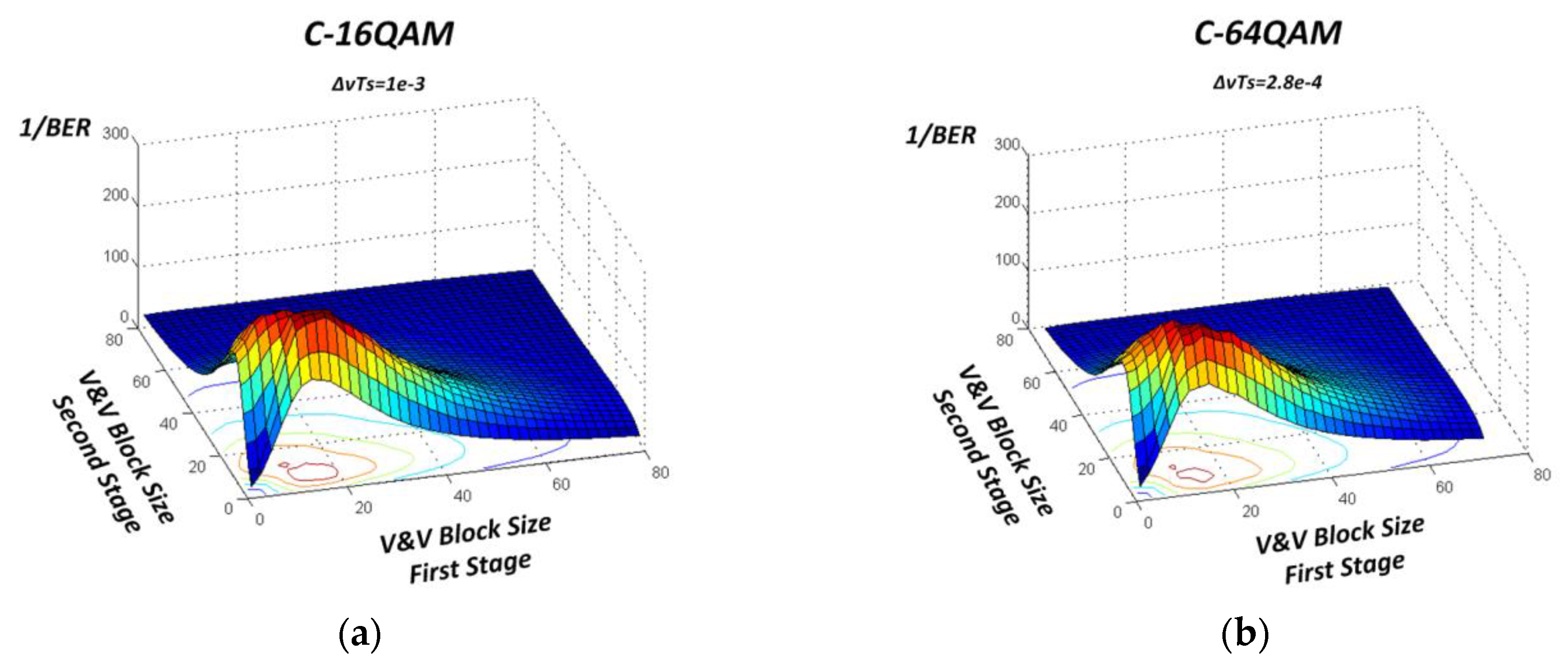




| Real Multipliers | Real Adders | Comparators | |
|---|---|---|---|
| BPSSq-mQAM | |||
| BPSC-mQAM | |||
| n-PSK2Stages C-16QAM | |||
| n-PSK2Stages C-64QAM | |||
| n-PSK2Stages C-16QAM sub-optimal | |||
| n-PSK2Stages C-64QAM sub-optimal |
| Algorithm | Reduction Factors [DC = 1, M1 = M2 = 19] (Multipliers | Adders) | Specifications |
|---|---|---|
| BPS Sq-16QAM | 3.8 | 3.3 24.5 | 30.1 | M = 19, β = 32, DC = 0 M = 19, β = 32, DC = 1 |
| BPS Sq-64QAM | 2.6 | 1.9 59.1 | 63.3 | M = 19, β = 64, DC = 0 M = 19, β = 64, DC = 1 |
| BPS C-16QAM | 24.5 | 30.1 | M = 19, β = 32, DC = 1 |
| BPS C-64QAM | 29.1 | 32.2 | M = 19, β = 32, DC = 1 |
| Algorithm | Reduction Factors [DC = 1, M1 = M2 = 19] (Multipliers | Adders) | Specifications |
|---|---|---|
| BPS Sq-16QAM | 2.4 | 1.8 15.2 | 16.6 | M = 19, β = 32, DC = 0 M = 19, β = 32, DC = 1 |
| BPS Sq-64QAM | 1.4 | 0.9 31.8 | 32.5 | M = 19, β = 64, DC = 0 M = 19, β = 64, DC = 1 |
| BPS C-16QAM | 15.2 | 16.6 | M = 19, β = 32, DC = 1 |
| BPS C-64QAM | 16.1 | 16.5 | M = 19, β = 32, DC = 1 |
© 2016 by the authors; licensee MDPI, Basel, Switzerland. This article is an open access article distributed under the terms and conditions of the Creative Commons Attribution (CC-BY) license (http://creativecommons.org/licenses/by/4.0/).
Share and Cite
Rodrigo Navarro, J.; Kakkar, A.; Pang, X.; Iglesias Olmedo, M.; Ozolins, O.; Da Ros, F.; Piels, M.; Schatz, R.; Zibar, D.; Jacobsen, G.; et al. Two-Stage n-PSK Partitioning Carrier Phase Recovery Scheme for Circular mQAM Coherent Optical Systems. Photonics 2016, 3, 37. https://doi.org/10.3390/photonics3020037
Rodrigo Navarro J, Kakkar A, Pang X, Iglesias Olmedo M, Ozolins O, Da Ros F, Piels M, Schatz R, Zibar D, Jacobsen G, et al. Two-Stage n-PSK Partitioning Carrier Phase Recovery Scheme for Circular mQAM Coherent Optical Systems. Photonics. 2016; 3(2):37. https://doi.org/10.3390/photonics3020037
Chicago/Turabian StyleRodrigo Navarro, Jaime, Aditya Kakkar, Xiaodan Pang, Miguel Iglesias Olmedo, Oskars Ozolins, Francesco Da Ros, Molly Piels, Richard Schatz, Darko Zibar, Gunnar Jacobsen, and et al. 2016. "Two-Stage n-PSK Partitioning Carrier Phase Recovery Scheme for Circular mQAM Coherent Optical Systems" Photonics 3, no. 2: 37. https://doi.org/10.3390/photonics3020037





